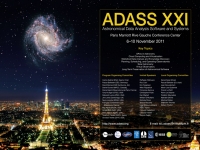Juan Carlos Vallejo (GMV, A.D.), O. Perez , R. Vazquez, (GMV AD)
Abstract
XMM-Newton is an ESA X-ray cornerstone observatory mission, operating continuously with great success since 2000, at a rate of around 300-350 refereed publications/year. Because of that, continuous efforts for keeping the processing capabilities along its operational lifetime and beyond are being performed. Coordinated with the SAS Analysis System and XSA mission archive activities, we describe here the works done in the operational side. The Science Control System (XSCS) is in charge of the L0/L1 processing. It includes the Payload Monitoring Systems, Observation Data System and the Archive Management Systems. These suffered the first ever in flight major upgrade in 2005. However, since then, software and hardware have still evolved a lot. So the raw TM data processing and conversion into useful scientific format facilities are facing again a migration process. Highly constrained by available time and resources, it is based in two approaches. Aiming the quick removal of old h/w dependencies, it combines the refactoring of some systems using modern languages with the virtualization of some others. Indeed, the virtualization allows the removal of ad hoc systems by more modern approaches that fulfill or even increase the same functionalities without major efforts. After this stage, the old architecture based in a monolithic approach should have been converted into a modular architecture. Different issues are to be taken into account depending of the module to consider, the database system or the FITS files creation modules. Starting from the fact that the XSCS already incorporates in some places the possibility of having a distributed processing architecture, sharing the TM processing among several clients, this sharing approach is to be further extended to all obtained modules, aiming to reach a final web services oriented architecture based into today's technologies. Synergies with Earth Observation preservation activities are also to be used. This will allow the preservation of the L0/L1 Data processing capabilities up to the foreseen end of the mission, and any final reprocessing of the L0 data which may be required in order to seed the public archive with the most possible updated data.Poster in PDF format
Paper ID: P155
Poster Instructions
|

